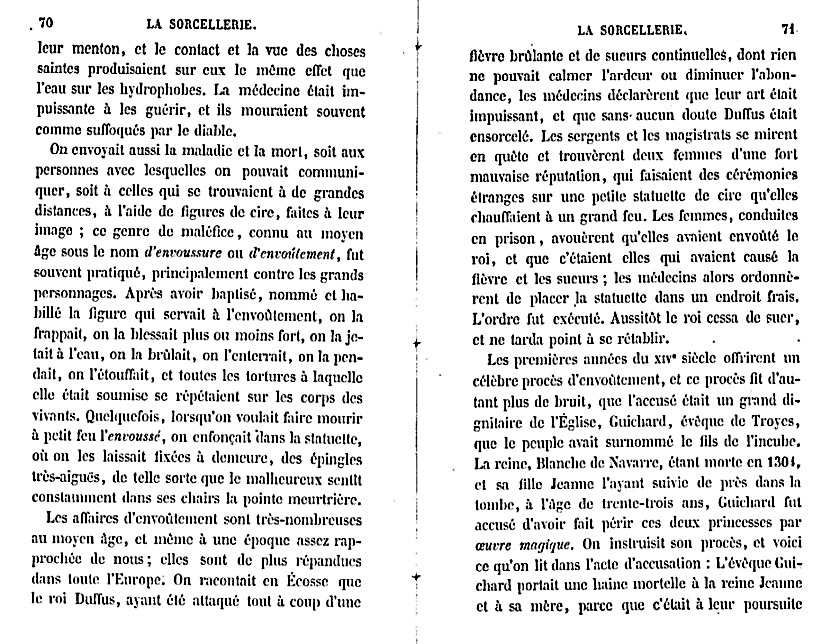|
Translation:
Operations of sorcery against the men. - appalling Diseases. -
Envoûtement. - The fever of King Duffus, The Guichard bishop,
The
Reine Blanche and his/her Jeanne daughter. - Envoûtement at the
court of France to XVIème century.
extracted from: "http://perso.infonie.fr/la.mission/sorcellerie.htm"
While following the practices of sorcery according to the ascending scale of
the beings, we arrive of the elements at the matter, the matter to the animal,
the animal to the man, and we find the magician operative on his similar and,
in last analysis, on itself; in other words, the wizard bewitches the others and
also finishes leave ' to bewitch. Here still we will follow it step by step through
its dark practical.
When the wizard acts on the others or for the others, it is, in general, to harm
or be useful of guilty passions, and in that it differs primarily from the
enchantor and even from the magician, such as the latter is presented by the
Eastern beliefs, yes by the oldest poems chevaleresques, because in these
poems, as in these beliefs, the magician makes more volontiersle although
evil, and one can take it without scruple for a scientist or wise. As for the
wizard it is always and everywhere, in its relationship with its similar, the man
we higher saw making a pact with the devil; it is always a being, fundamentally
malicious, one will judge some by what follows.
Like the gods of the hell, pagan, the wizard cannot be emotional and for, to be
avenged for its enemies, to sometimes even torment by pleasure those which
make him desire, it strikes them appalling diseases. M of Saint-Andrew speaks about a girl bewitched, who, after having lost the movement and
breathing, vomits, during several months, of the egg hulls, glass, the shells,
the nails of wheels of carriage, the knives, the needles and the balls of wire.
Others vomitted toads of the snakes, owls; some- times the wizard ordered with
the devil itself entrer' in the body of the victim, and then, one saw occurring,
by the effect of the evil spell, all the phenomena of the possession. Bewitched
which, carried in them another being, was diverted company of the men to
exile itself in the cemeteries, and until in the tombs.
Their figure had the color of the cedar; their eyes rouges' as trim, left the
orbits; their language, rolled like a horn, hung on their chin, and the contactet
the sight of the holy things, produced on them the same effect as water on the
hydrophobic subjects. Medicine, was impotent, with, to cure, and they often
died as suffocated by the devil.
One sent also the illness and death, is to the people with whom one could
commun- icate is with those which were at long distances, using wax figures,
made with their image; this kind of evil spell, known, with the Middle Ages
under the name of en- voussure or of envoûtement, often was practised, mainly
against the large charac- ters. After, having baptized, named and equipped the
figure which was used for envoûtement, one struck it, one wounded it more or
less extremely, one threw it to water, one burned it, one buried it, one hung it,
one choked it, and all tortures to which it was subjected repeated on the bodies
of the alive ones. Sometimes, when one wanted to make die in small envoussé
fire one inserted in the statuette, where they were left fixed at residence, of
the very acute pins, so that the unhappy one constant- ly smelled in its flesh the
fatal point.
businesses of envoûtement are very numerous with the Middle Ages, and
even at a time brought closer us enough; they are more widespread in all
Europe. One told in Scotland that king Duffus having been attacked suddenly
of a fever, extreme and continual sweats, of which nothing could calm the heat
or decrease abundance, the doctors declared that their art was impotent, and
that without any Duffus doubt was bewitched. The sergeants and the magistrates are reflected in search and found two women of a fort bad
reputation, who made strange ceremonies, on a small statuette, of wax which
they heated with a large fire. The women, led in prison, acknowledged that
they had, envoûté the king, and that it was they which had caused the fever
and sweats; the doctors then ordered to place the statuette in a fresh place.
The command was carried out. At once the king ceased sweating and was not
long in being restored.
The first years of XIVe century offered a famous lawsuit of
envoûtement, and
this lawsuit all the more made, noise that the defendant was a high-ranking
dignitary of the Church, Guichard, bishop of Troyes that the people had called the son of incubates. The queen, White of Navarre,
having died in 1304, and his/her Jeanne daughter having followed it, close, in
there falls, at the age of trente-trois years, Guichard. Perish these two
princess S by magic work was shown to have made, One informed her lawsuit;
and here what one reads in the bill of indictment: The Guichard bishop carried
a hatred mortal to the Jeanne queen and his mother because it was with their -continuation which it had been driven out of the consulting of
Roi.s' was
praised to make them:mourir and had joined to this end a witch, a inspiritée
woman, and a monk Jacobin; they had all three evoked the devil and the questioned devil had answered. that it failed to make a wax image, resembling
to the queen, to baptize it, give him the names of this princess, to approach it,
of fire, to prick it with a needle with the neck and the tète; that there, queen
then would start badly to go, and that she would die at once that the wax
seraitfondue;d' after this consulting of the devil, Guichard made the image and
jointly baptized it with the Jacobin, in the Sainte-Flavy hermitage; it dissolved
there the image and at once the queen died.
Many witnesses were questioned, inter alia the hermit of Saint-Flavy, who
confirmed the facts; the bishop was condemned, but the character of which it
was covered saved it last torment, and it remained in prison until 1313, time to
which its innocence was recognized. About same time, charges of Sorcery were
as, one knows, carried it against the templiers, but less happy as the bishop
Guichard, they expièrent on roughing-hew it the crimes, for the majority
imaginary, of which one had charged them.
In XVIè, century, the fashion of the envoûtements became completely
popular, One often knows that the duchess of Montpensier employed, this evil
spell against Henri III. and that it resorted to the dagger of Jacques Clément
only after having recogniz- ed uselessness of it. Catherine de Médicis, who
sponsored all the madnesses and all the scélératesses, was useful herself also
several times of envoûtement, while fear- ing for itself her terrible effects, and
when the Mole and Coconas were delivered to the last torment, it was shown
extremely worries to know if they had envoûtée it it is only indeed
moment when the effectiveness of this practice was allowed, there was no
more, security, even within the absolute power, and keeps it barriers of the
Louvre did not defend the kings of them.
|



